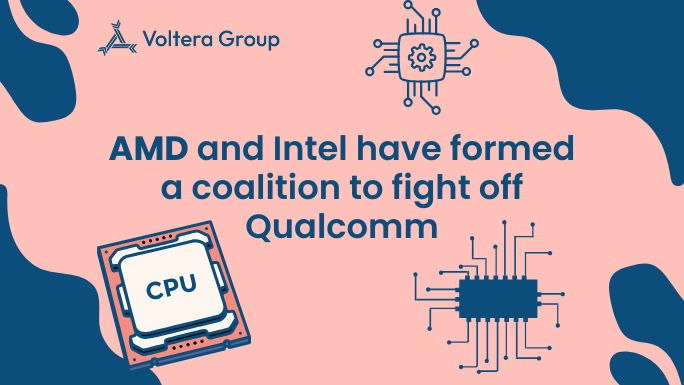In a surprising yet strategic move, two of the world’s leading chip manufacturers, AMD and Intel, have joined forces to tackle a rising challenge in the semiconductor industry—Qualcomm. As Qualcomm expands its footprint in both the mobile and laptop processor markets, AMD and Intel, once fierce rivals, are collaborating to address a common adversary. Qualcomm’s aggressive push into ARM-based chips, particularly for mobile devices and ultrathin laptops, presents a significant challenge to the long-standing dominance of x86 architecture, which has powered the majority of computing systems for decades.
This coalition marks a pivotal moment in the tech industry, as both companies recognize the growing impact of Qualcomm’s low-power, high-efficiency ARM processors. These chips have gained traction in 5G-enabled laptops and always-connected PCs, offering superior energy efficiency and features that resonate with modern users. By joining forces, AMD and Intel aim to safeguard their leadership in the rapidly evolving semiconductor landscape, ultimately reshaping the future of computing and mobile devices as they combine resources and expertise to counter Qualcomm’s advances.

The Qualcomm Challenge: Rising Dominance in Mobile and Beyond
Qualcomm has long been a major player in the mobile chipset market, dominating the smartphone industry with its Snapdragon processors. These chips have powered most Android devices, delivering high performance and energy efficiency. However, Qualcomm’s ambitions have extended beyond mobile phones. The company is aggressively entering the laptop, tablet, automotive, and even data center markets, challenging the established dominance of Intel and AMD in these sectors.
Qualcomm’s expertise in ARM-based architectures and its focus on low-power, high-efficiency chips have positioned it as a serious contender in markets traditionally dominated by x86 architectures—Intel and AMD’s core competency. With products like the Snapdragon 8cx, Qualcomm is increasingly competing with Intel’s Core and AMD’s Ryzen processors in ultra-thin laptops and tablets. Furthermore, the rise of 5G and the Internet of Things (IoT) has created new opportunities for Qualcomm, leveraging its chips optimized for wireless connectivity and edge computing, areas where Intel and AMD have been slower to respond. This shift presents significant pressure, as Qualcomm threatens to encroach on markets that were once secure for both companies.

Why AMD and Intel Are Joining Forces
The notion of AMD and Intel collaborating may seem unimaginable given their historical rivalry. For decades, these companies have competed fiercely for dominance in the PC and server markets, with Intel typically holding the lead in market share, while AMD has earned recognition for its innovative, high-performance, and cost-effective solutions.
However, the tech industry is rapidly evolving, and both companies recognize that their traditional x86 architecture is increasingly pressured by ARM-based competitors like Qualcomm. By uniting, AMD and Intel can pool resources, expertise, and market influence to stave off Qualcomm’s rise. Here are the key reasons behind this partnership:
Preserving x86 Architecture Dominance
At the heart of this partnership lies a shared interest in preserving the dominance of x86 architecture, which powers most desktops, laptops, and servers. Qualcomm’s focus on ARM chips poses a direct threat to x86’s reign, especially as ARM gains momentum in cloud computing and edge devices, where efficiency and scalability are critical.
Combining R&D Strengths
While AMD and Intel have historically competed over performance and innovation, Qualcomm’s advantages in power efficiency and wireless communication technologies have prompted a need for collaboration. By joining forces, AMD and Intel can combine their R&D efforts to develop new, cutting-edge solutions that balance high performance with energy efficiency, targeting not just traditional PCs and servers, but also mobile devices, laptops, and IoT markets.
Leveraging Manufacturing Expertise
Intel’s renowned manufacturing capabilities have faced challenges in recent years, particularly with delays in its 7nm and 10nm production processes. In contrast, AMD outsources chip production to TSMC, which has maintained its manufacturing lead. This coalition allows Intel and AMD to leverage each other’s strengths—Intel’s scaling capabilities combined with AMD’s access to leading-edge manufacturing technologies.
Creating an Alliance Against ARM-Based Processors
ARM-based processors have gained substantial traction due to their performance-per-watt efficiency and dominance in mobile devices. Qualcomm, as a leader in ARM technology, is poised to disrupt the PC and server markets. Through collaboration, AMD and Intel can counteract ARM’s rise with new hybrid architectures that offer similar or superior efficiency while maintaining the legacy software support of x86.
What This Coalition Means for the Industry
The partnership between AMD and Intel is not merely a defensive maneuver; it represents an offensive strategy aimed at future-proofing their positions in a rapidly evolving tech landscape. This coalition emphasizes several key areas that will reshape the semiconductor industry:
A New Focus on Energy Efficiency and Performance
To compete with Qualcomm’s chips, known for their excellent balance of performance and energy efficiency in mobile devices, AMD and Intel will likely invest in hybrid processors that merge traditional strengths with lower-power architectures. These new processors could combine high-end computing power with ARM-level efficiency, appealing to next-gen laptops, tablets, and potentially even smartphones.
A Strengthened Server and Cloud Market
Qualcomm’s recent moves into data center chips, such as its Centriq processors, pose a challenge in the cloud computing space. While these efforts haven’t toppled Intel’s dominance, the threat is palpable. AMD’s EPYC processors have gained traction in the server market as well. By collaborating, AMD and Intel can ensure that their products continue to meet the evolving demands of cloud and enterprise markets, presenting a stronger front against ARM-based solutions.
Battling Qualcomm in the 5G and IoT Space
Qualcomm’s advantage in 5G and IoT technologies, with chips powering connected devices, smart cars, and industrial IoT applications, necessitates a united front from AMD and Intel. By aligning their efforts, they can advance their own IoT solutions and accelerate the development of 5G-capable processors that offer superior performance for connected devices.
The Potential for Co-Developed Products
While AMD and Intel will likely maintain their individual product lines, the potential exists for co-developed chips that blend the best of both worlds. Imagine a processor that integrates AMD’s advanced graphics capabilities with Intel’s AI and machine learning optimizations. This collaboration could provide a competitive edge in sectors like gaming, AI workloads, and high-performance computing (HPC).
What’s Next for Qualcomm?
Qualcomm is not expected to back down easily. Already a dominant force in the mobile industry, its ARM-based technology provides a unique advantage. However, with AMD and Intel collaborating, Qualcomm may face stiffer competition, particularly in the laptop and edge computing markets. To stay ahead, Qualcomm will need to innovate rapidly and leverage its expertise in mobile and wireless technologies.
Voltera Group’s Role in the Evolving Semiconductor Landscape
At Voltera Group, we are actively monitoring and analyzing these developments in the semiconductor industry. Our commitment to innovation and cutting-edge technology positions us to support our clients in navigating the complexities of this rapidly changing landscape. By staying ahead of industry trends and collaborating with key players, we aim to deliver solutions that empower businesses to thrive in a competitive environment.
As AMD and Intel navigate their partnership to combat Qualcomm, Voltera Group remains dedicated to fostering innovation and providing insights that drive success in the tech sector.





